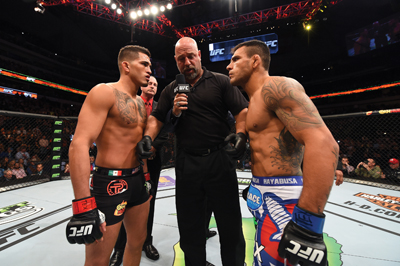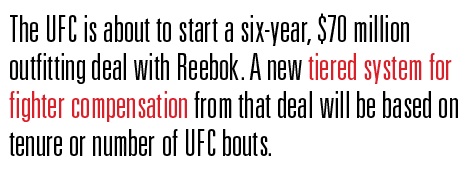Since the UFC agreed to its first exclusive outfitting deal with Reebok in December, executives from the promotion’s newly formed equipment department have spent hours meeting with fighters, their cornermen and their managers, explaining how their lives will change when the Reebok deal takes effect in July.
Along the way, one issue has become clear: Fighters want to know how they’re going to be compensated under the six-year, $70 million deal — and their thoughts on the subject have prompted a change in the payment model that the UFC originally developed.
“We’ve had some great discussions, and the fighters and managers have asked some terrific questions,” said Tracey Bleczinski, UFC senior vice president of global consumer products. “There’s been some good debate.”
When the UFC released the initial draft of its outfitting policy in January, it stipulated that fighters’ compensation for a given bout would be based on their rankings. But based on feedback collected during the information sessions, the UFC has opted instead to institute a tiered system based on tenure, or number of UFC bouts fought. Fighters also will be credited for bouts sanctioned by World Extreme Cage Fighting and Strikeforce, both of which were purchased and shuttered by UFC parent company Zuffa.
The new system places combatants into tiers of 1-5 fights, 6-10 fights, 11-15 fights, 16-20 fights and more than 21 fights. The only exception applies to title fights, as both title challengers and reigning champions will receive greater compensation. The UFC declined to share specific dollar figures for each class.
The UFC considers this model preferable for fighters because number of bouts is an objective scale, whereas fighters’ rankings are determined by media members and are subjective in nature. It plans to officially notify fighters of the change in the coming weeks.
Still, observers are asking how fighters’ compensation under the Reebok deal will compare to what they were being paid previously by individual sponsors to wear their logos in the Octagon. While most UFC fighters had once generated the majority of their income by wearing sponsors’ logos, they now are prohibited from wearing those logos during any UFC Fight Week events, including public training sessions, news conferences, weigh-ins and fights.
Authentic Sports Management CEO Glenn Robinson, who represents a group of fighters known as the Blackzilians across several combat sports, said that the sponsorship money fighters previously depended on has declined in recent years.
“There was once a real big heyday of sponsorships. There was a time when companies like Tapout were paying $50,000 to $75,000 per fight, and people were living off that sponsorship money,” Robinson said. “But those days are gone. That income level of sponsorships is not there anymore. It doesn’t exist, and a lot of fighters still count on that money.”
WME agent Brad Slater, who represents a high-profile stable of fighters including Ronda Rousey, echoed that sentiment. “The money that was garnered in large part, even if you saw five or six sponsors on people, would not necessarily always add up to a really significant number,” Slater said.
Robinson, in addition to managing fighters, owns a clothing brand called Jaco, which previously promoted itself on
 |
Originally, UFC proposed compensating fighters based on rankings.
Photo by: Getty Images |
fighters’ apparel during bouts. Still, he said from a fighter management perspective, he believes compensation via the Reebok deal is more sustainable and, therefore, better for his clients.
“You have a lot of companies that would come in for a brief period of time. They’ll sponsor really heavy for some period of time and then they go away,” Robinson said. “They don’t stick with the league for a long time because there’s not a lot of return on investment for them, whereas for Reebok, there’s a return on investment. The fighters are all getting behind a brand, the brand is going to be available for sale, so there’s a way for them to recoup their money, and there’s a cycle for the funds. Reebok makes an investment, the fighters get money, Reebok gets their money back by sales.”
Meanwhile, bringing on an official outfitter should help elevate the UFC toward the same echelon as other major sports leagues from a presentation standpoint.
“The fighters doing individual sponsorship deals and things like that … has been a tough look for the UFC,” said Mike Lunardelli, Reebok director of combat training. “It’s been a little bit all over the place. That was one of the things we talked about: How do we clean that up?”
Each fighter’s kit will feature the UFC logo, Reebok’s logo, a single sponsor logo determined by the UFC, and the fighter’s full name.
Both the UFC and Reebok said they have made efforts to allow fighters to maintain their individuality in the Octagon, but Bleczinski said fighters have not been involved in the design process in terms of aesthetics, though they have been consulted about their performance needs and involved in testing.
Fighters prior to fight week will be able to choose from a variety of shorts styles, as well as color preferences. Lunardelli added that fighters’ nationalities will be reflected in their garb, as well.
For Reebok, partnering with the UFC represents an opportunity to target a younger audience as well as to further itself as a key player in the fitness space. Lunardelli cited the company’s market research as showing that 35 million people around the world are “training like fighters,” 40 percent of whom have begun doing so in the past year. “As we saw that happening, we wanted to find a way to get into this space,” Lunardelli said.
Bleczinski said Reebok was one of several companies that expressed interest in becoming the UFC’s official outfitter, though she declined to identify the other brands. Nike, Under Armour and Adidas all had deals with individual fighters before the UFC signed its agreement with Reebok.
Alex Silverman is a staff writer for SportsBusiness Daily.





